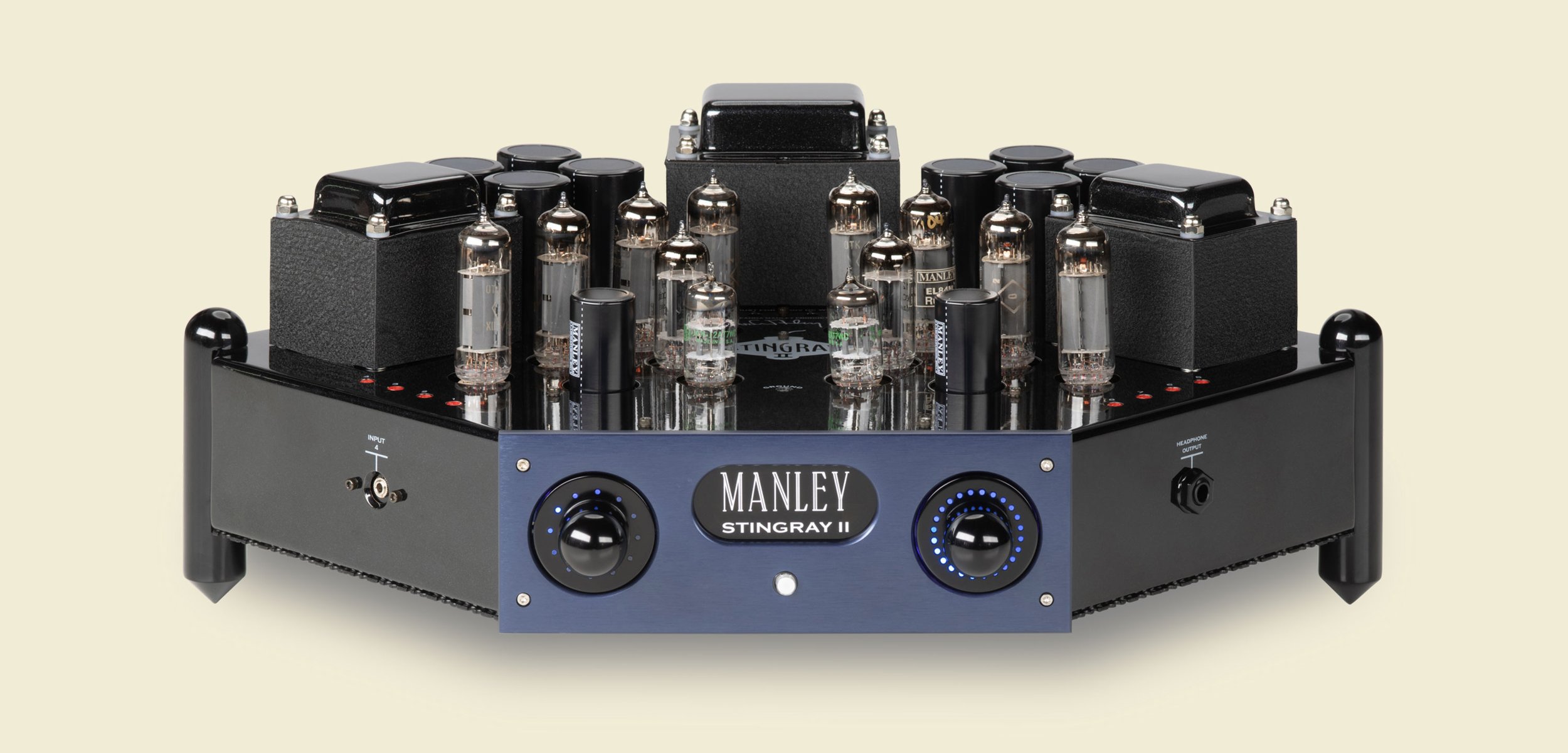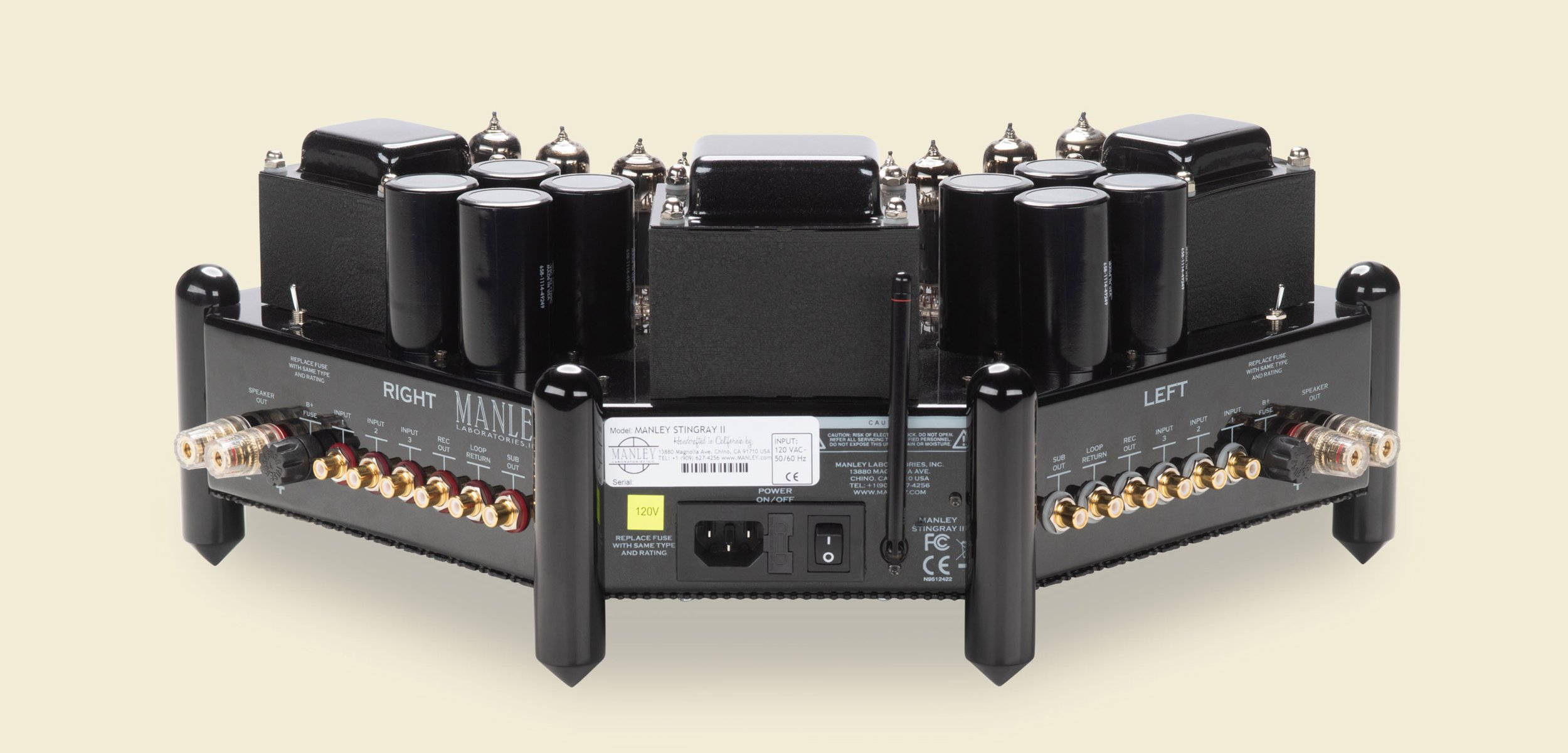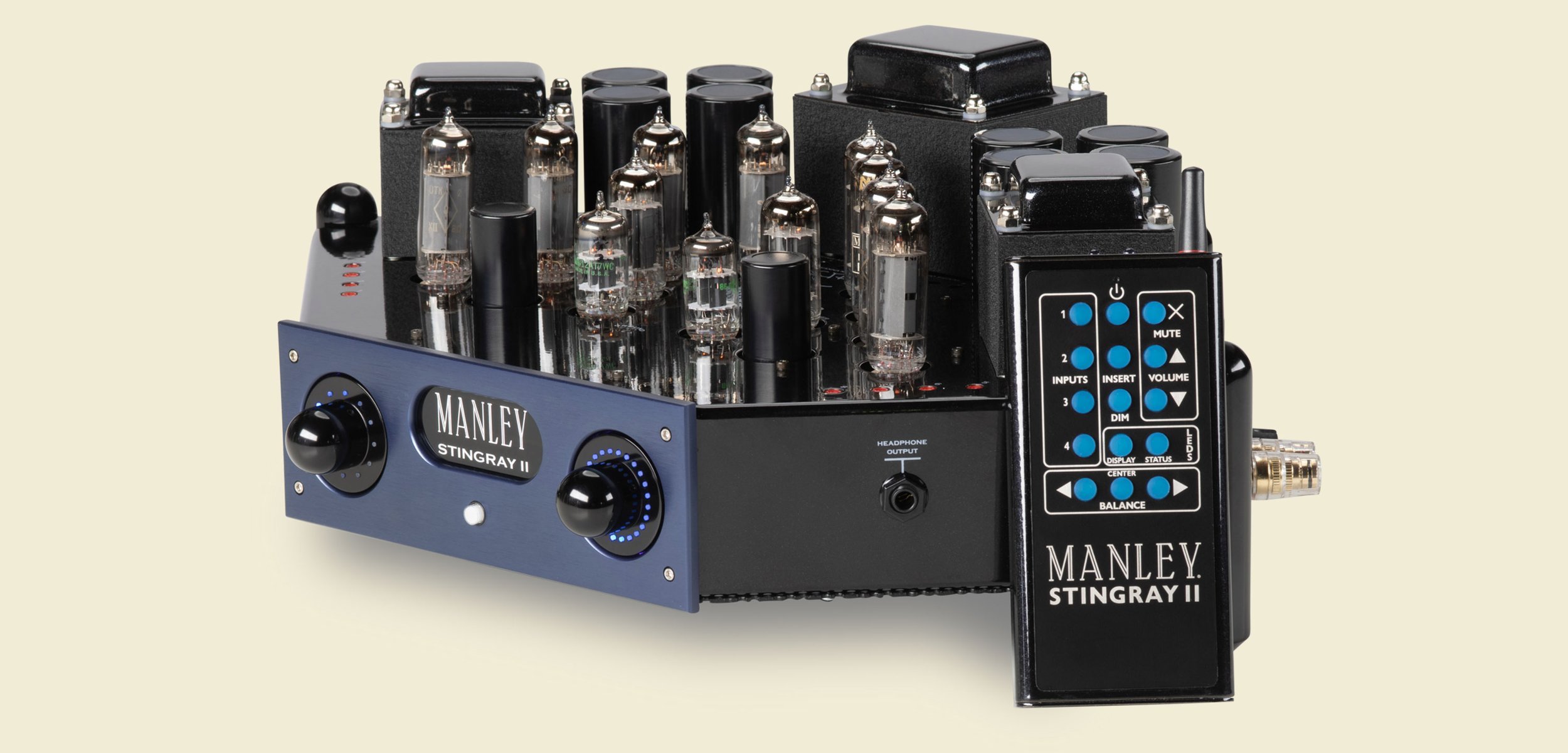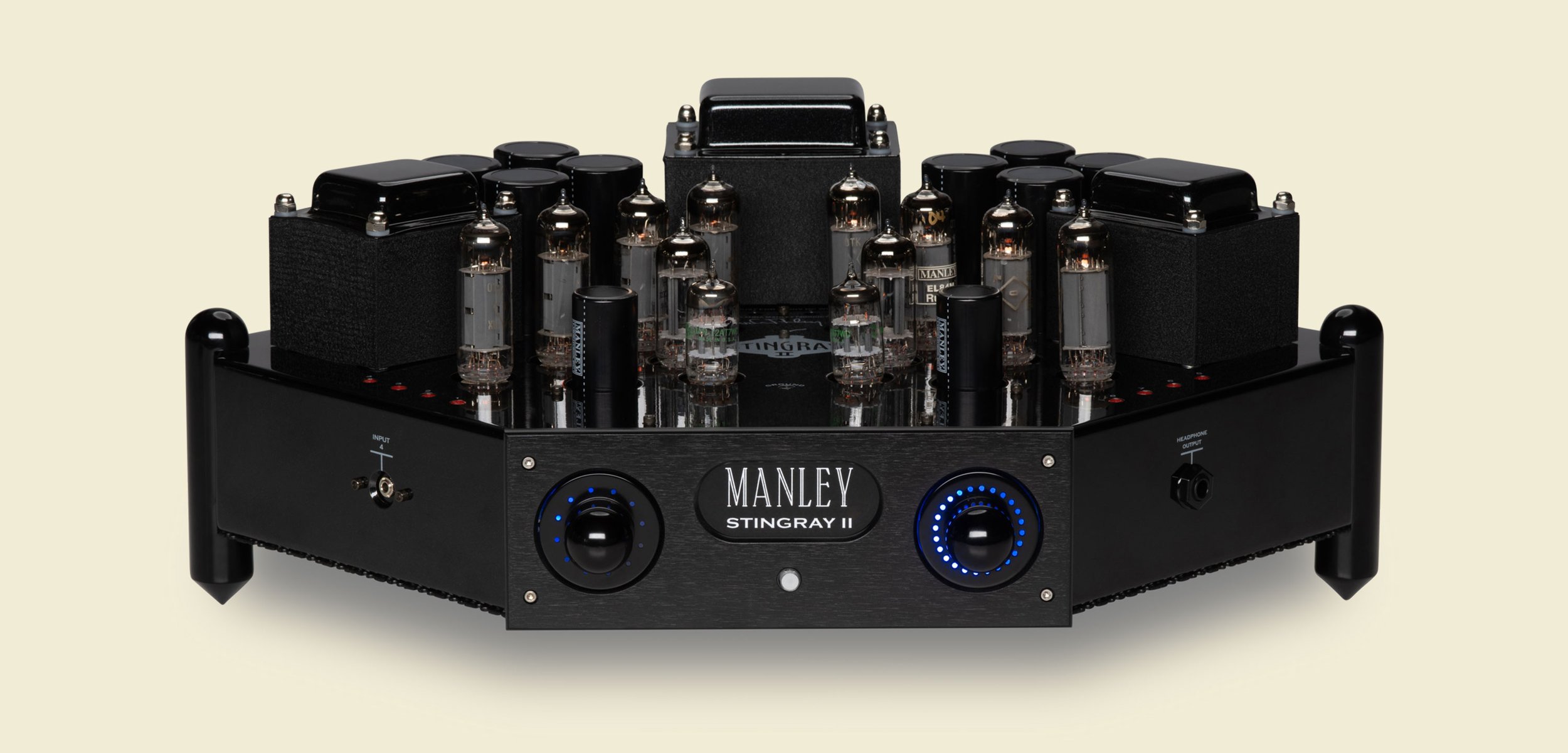
From our most advanced evolution of the Stingray, expect even more coherent bass definition and solid brawn from the larger high voltage energy storage. The EL84 output stage can be switched between 20 Watts of TRIODE power or 40 Watts of Ultra-Linear mode push-pull operation. The headphone output takes advantage of the entire amplifier and every ounce of attention to detail we have poured into this fantastic design. RF remote control included.

DETAILS
The famous Manley Stingray stereo integrated amplifier has been renewed and refreshed. Allow us to present to you the Stingray II integrated tube amplifier with full featured RF and IR remote control. We also make another model with a built-in iPod dock called the Stingray iTube that you can learn about here.
The STINGRAY II is the next evolution from our acclaimed Stingray Integrated Amplifier, legendary in the hifi world since it first swam from our labs in 1997. Originally conceived with particular attention paid to optimal component placement for the purity and symmetry of the signal path layout, the Stingray quickly became one of our best-selling products. The Stingray II retains the same basic tube circuitry and marvelous output transformers as the original with some important improvements:
The high voltage tube energy storage has been increased vastly resulting in even more solid and coherent bass control and impact.
A headphone jack has been added to the right side facia. This jack re-routes the output from the speaker binding posts and mutes the Subwoofer output feed. This makes the Stingray II a fabulous headphone amplifier!
The 4th input source is an 1/8" (3.5mm) TRS mini jack for convenient hookup with portable devices and computers on the left front facia.
The Remote Control works with both Radio Frequency and InfraRed technologies. Using the remote in RF mode gives freedom from having to "point and shoot." The RF remote is omnidirectional and works through walls and cabinets. IR capability is included for those with Universal Learning Remote Controls for consolidated integration into existing systems. The volume control, balance adjust, input switching, and display options are all on the RF/IR Remote Control. Additionally user can perform the MUTE, DIM, INSERT and STANDBY commands with the Remote Control.
Each INPUT can be individually level trimmed to match and to optimize system gain staging of various input devices.
The fancy blue LED displays surrounding the INPUT and VOLUME encoder knobs can be dimmed down or turned off entirely, after a user-settable time period, or a "screen-saver" random light sequence can be selected. Speed and intensity of the "Starlight" mode can be tweaked to taste.
All custom user settings are hard written into memory when the unit is put into STANDBY mode and thus retained if power is later interrupted.
There is even a SLEEP timer which is programmable from the remote control to allow you to drift off carefree dreaming of your musical Stingray for 15, 30, 45 or 60 minutes while it gracefully lowers the volume and puts itself into STANDBY mode.
Individual sealed gold contact relays deliver the selected input into the volume control system before hitting the first 12AT7 input tubes. Following the mighty 12BH7 (previously 6414) driver/phase splitter, the trusty EL84 output stage can be switched between either 20 watts of TRIODE power or 40 watts of Ultra Linear mode push-pull operation. Individual bias for each tube is easily adjusted using the trimpots and test points, conveniently located on the top surface of the amplifier. The Stingray's power supply is extra-rugged and stiff, a MANLEY hallmark. It swims with the sharks: fast, agile, fluid, and with consummate authority.
Post-volume SUBWOOFER OUTPUT allows easy hookup of outboard line-level driven active powered subwoofers. This output is after the volume control so that the subwoofer will track the volume level changes of the main speakers. The SUB OUTPUT is a line level and full frequency output that is AFTER the volume control so your powered subwoofer follows the same volume as your main speakers. These are unbalanced RCA jacks, line level. They feed the line inputs of your subwoofer, NOT the speaker jacks.
A switchable TAPE LOOP is standard. The TAPE SEND is the output of the selected input before the volume control. The TAPE RETURN can also be used as a 5th line input if needed.
RECORD OUT (aka Tape OUT) is BEFORE the volume control so you can record whatever input you have selected without your listening level affecting the level going to your recorder. These are unbalanced RCA's. It is UNbalanced RCA's and UNbuffered so check out the input Z to your recorder to make sure it won't load down the Stingray main input while it is plugged in. Usually with unbuffered record outs we recommend you only plug in your recorder only when you are actually recording...
Tape LOOP: Also known as an INSERT point, the SEND or Tape Out comes off the selector switch as the Record Out option does going to your outboard EQ or Merlin BAM unit or tape recorder and then the signal returns (RETURN) to the Stingray in front of of the volume control so you can play tunes. A toggle switch selects whether the Tape LOOP (and whatever is plugged into the Tape Loop) is active or the signal goes straight through the Stingray as normal. If you have the Merlin BAM system, order your Stingray with the Tape LOOP option.
NOTE: The SUBWOOFER OUT, RECORD OUT, and TAPE LOOP are all passive. The RECORD OUT comes straight off the input select switch. So whatever source is selected will show up passed through at the TAPE OUT. With the Stingray, the MANLEY team has struck a remarkably harmonious balance in design which satisfies the sonic desires of the audiophile and the rocker, the artist and the musician, the student and the master, the yin and the yang. We invite you to experience the stunning sonic quality and visual beauty of the Stingray personally.
SPECIFICATIONS
3 x Stereo Line RCA Inputs
1 x Stereo Line 1/8" TRS mini-jack Input
TRIODE - UL Output Stage Mode Switching
RECORDING OUT
SUBWOOFER OUT
TAPE LOOP (Insert) with Bypass switch
1/4" Headphone OUTPUT (mutes speakers and subwoofer output when deployed)
Logic controlled Volume and Balance functions
All-Vacuum Tube Lo-feedback Stereo Integrated Design
Output Tubes: 8 x EL84 Ships with Russian NOS EL84M (aka 6Pi14Pi-EB)
Driver Tubes: 2 x 12BH7EH (previously 6414) dual triodes
Input Tubes: 2 x 12AT7EH Ships with: 12AT7EH large plate Electro-Harmonix Russian
Maximum Output Power UL mode: 32 Watts x 2 channels 1.5% THD @ 1kHz into 5 Ohms
Maximum Output Power TRIODE mode: 18 Watts x 2 channels 1.5% THD @ 1kHz into 5 Ohms
Frequency Response: 15 Hz - 58 kHz, -1dB
Gain: 35 dB at max Volume
Input Sensitivity UL Full Power: 210 mV in = 32 watts out into 5 Ohms with volume control at maximum
Input Sensitivity Triode: 41mV in = 1W into 5 Ohms with volume control at 20dB gain setting
Input Sensitivity UL: 35mV in = 1W into 5 Ohms with volume control at 20dB gain setting
Crosstalk: -72dB See Chart
S/N Ratio: typically 72 dB A-WGT, 1W output, 20dB gain, Source Z = shorted input
THD+N Ratio: typically 64 db at 1W output, Bandwidth 22Hz-22kHz, Source = 1kHz Sine wave
Input Impedance: 12 kOhm nominal
Optimum Speaker Load: 5 Ohms
Speaker Terminal Output Impedance: 2.36 Ohms @ 20Hz, 2 Ohms @ 1kHz, 1.83 Ohms @ 20kHz
Damping Factor: 2.4
Headphone Jack Output Impedance: 53 Ohms
Scratch Factor: Use pennies under pointed feet to avoid marring cabinetry. Try quarters if you are in upper tax brackets. The bargain performer would be nickels. Paper currency does not function as well. Euro coins work 1.54 times better.
Remote Control Type: RF (radio frequency) and IR (infrared), user selectable
Volume Control: Cirrus Digital Level Control System, controlled by Grayhill Rotary Encoders
Volume Control Range: 102dB in 1dB steps turning slowly, with larger steps as rate of turn increases
SLEEP timer: 15, 30, 45, 60 minutes
Power Consumption (Standby): 6W
Power Consumption Idle: 198W
Maximum Power Consumption at Full Power: 300W
Fuse type and ratings @ 117 VAC operation:
MAINS fuse: 3 Amp 3AG slow-blow use glass body Littlefuse Series 239Fuse type and ratings @ 230 VAC operation:
MAINS fuse: 1.6 Amp 3AG slow-blow use glass body Littlefuse Series 239B+ FUSES (2): MDA 1/4 AMP, 250 Volt SLO-BLO, Ceramic.
Power Supply: is factory set for 100V, 120V or 220-240VAC operation for original destination country's mains voltage.
Operating Mains Voltage: changeable with power transformer re-wiring on PCB and fuse value change.
Mains Voltage Frequency: 50 ~ 60 Hz
Power Cord: Detachable IEC standard.
Appropriate power cord supplied for original destination countryDimensions: W= 19", D=14", H= 7 1/2"
Shipping Weight: 35 lbs.
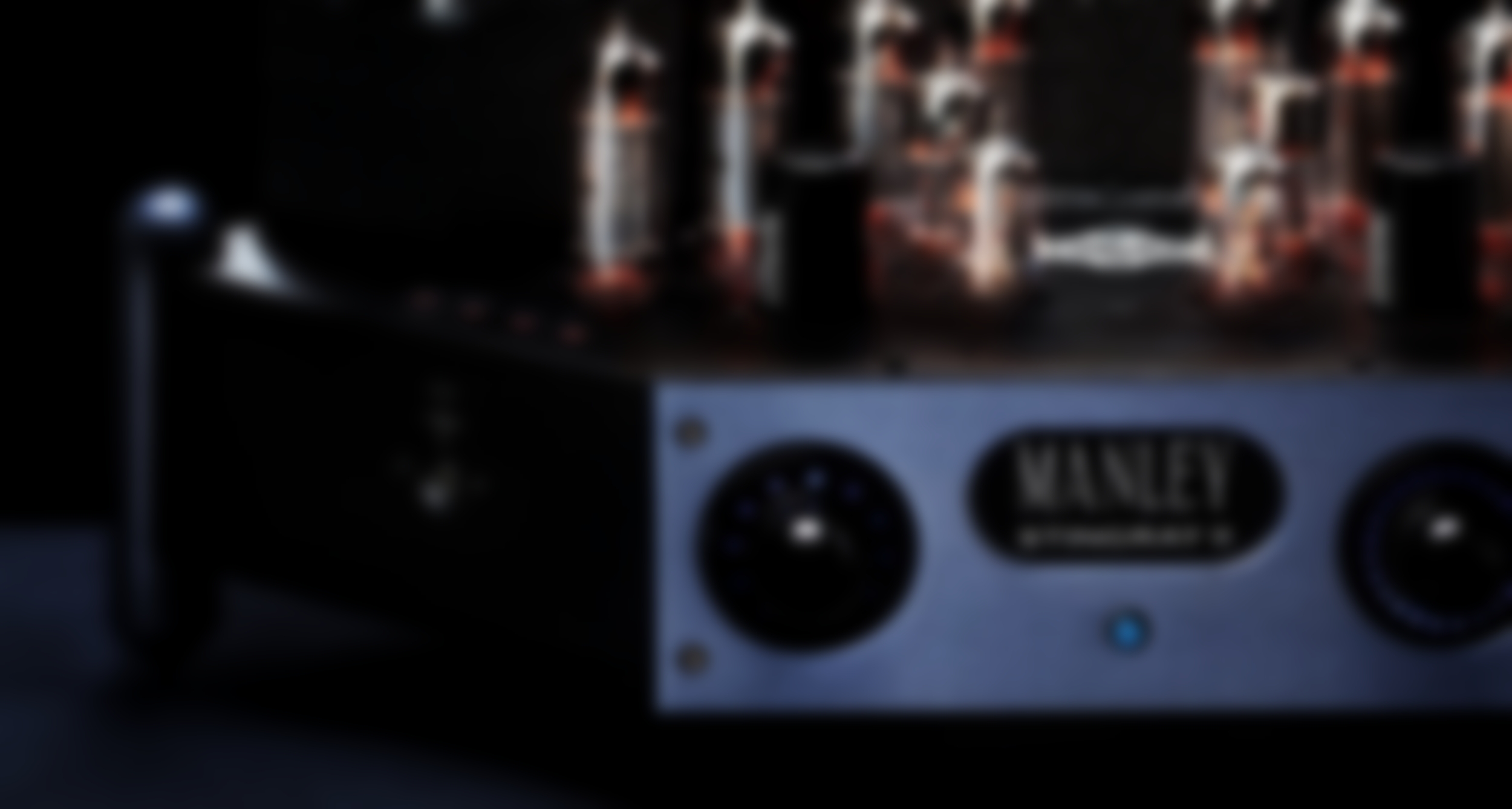
REVIEWS
“…lead instruments and voices, for example, positively drip with harmonic content. It manages to separate musical strands without pulling apart the production for forensic analysis, always putting the performance first. The result is a very beguiling yet engaging listen when this amplifier is giving off its best.”
“The Stingray II's designer EveAnna Manley has created an amplifier with music in its heart and soul, rather than going for the stark, brutalist approach of some hi-fi components. It brings out the joy of music, never highlighting flaws in recordings that often make you reach for audiophile test discs.”
- John Pickford, StereoNet (June 2023)
“…bit by bit, an extremely three-dimensional spatiality set in…the Stingray plays in a way that directly engages the listener.”
“With jazz combos, for example, I feel transported to the dense atmosphere of small music clubs; with large orchestral recordings, I experience the volume of the concert hall from a realistic distance. Dynamics, and especially fine dynamics, the Stingray leaves nothing to be desired, tonally it is natural and in love with detail.”
- Knuth Zensen, Fidelity (June 2023, German)
“Whatever you play though there is a fluidity to the sound that makes it extremely compelling, the Stingray II makes a lot of amplifiers sound mechanical, as if they are having to go through more processes to deliver the music…what more can you ask of a piece of audio electronics than to enhance the joy of music in the home? I know that music is a serious affair for many but we’re in it for the emotional connection and this funky amp is rather good at that.”
- Jason Kennedy, HiFi+ (December 2021)
"...the word ‘engaging’ is a great way to describe the Manley Stingray II sound...a sound that encourages you to switch off the analytical side of your brain and enjoy the music for what it is."
- Terry Ellis, Pursuit Perfect System (April 2021)
"…delivers a glow that makes you want to forget the daily hustle and bustle, turn down the lights, light a couple of candles and find yourself pouring yourself a glass of wine…goosebumps are guaranteed."
- Stereo+, Feb 2021 (Norwegian)
"…for anyone who wants to have an integrated tube amplifier for a long time without worrying about replacing it…the Stingray II will be the only amplifier that will stay with you for your lifetime."
- Audiophile Videophile, April 2019 (Thailand)
"High quality workmanship with obsessive attention to technical details, including the selection of NOS tubes. Tangible, subtle and musical sound, with great bass control and beautiful timbre."
"...the Stingray II sang. There was none of the glassy, hard-edged tube glare that can arise when a set of output tubes is pushed to deliver a maximum of power and a minimum of music. Tubes have their own way of sometimes turning nasty, and here they didn't."
- Sam Telling, Stereophile, September 2010
"ใครเล็ง Stingray II ซื้อเลยครับ แล้วมันจะอยู่กับคุณไปจนกว่าจะตายจากกันครับ."
- Audiophile Videophile, April 2019 (Thai)
"Wysokiej jakości wykonanie z wręcz obsesyjną dbałością o szczegóły techniczne, łącznie z doborem selekcjonowanych lamp NOS. Brzmienie namacalne, finezyjne i muzykalne, z basem o świetnej kontroli i pięknej barwie."

RESOURCES
FREQUENTLY ASKED QUESTIONS
Why can't I have balanced inputs?
The input stage of this amplifier, and the way the feedback is configured for the amplifier is configured for this single-ended input stage design. The input circuitry uses single-ended topology. In order to be able to provide balanced inputs we would have to convert the signal from balanced using something like some IC's or transformers. Both these options would add more "stuff" to the signal and be certainly audible detracting from the pure sound this amplifier provides. If you are driving this Stingray amplifier from a balanced preamplifier, check to see if you also have unbalanced outputs, change your cables and go with that. You might be pleasantly surprised that they too added extra audible "stuff" in order to provide balanced outputs and the RCAs on your preamp that don't have that extra "stuff" in the signal path actually sound better. (Depends on a given unit's specific design.) Or use some XLR to RCA adaptors. Most balanced gear has no problem driving single ended but check with the manufacturer if they are going to want the negative pin 3 of the XLR grounded or floating. Transformer-coupled XLR jacks always can drive single-ended by running Pin 2 to the HOT middle RCA pin and grounding pin 3 to the RCA outer shell. Some IC coupled XLR outputs will want pin 3 floating, others will require it to be grounded when driving a single-ended input. Check with the manufacturer of your gear to see how to hook it up to a single-ended input.
What tubes should I get for my Manley Stingray II?
You can get a complete retube kit right here on our webstore.
HELP! One channel is out!
First step, check bias readings on that channel. If all of the tubes are reading ZERO = 0.000 Volts DC, then the B+ fuse is blown. Turn OFF the unit. Consult the manual and change the fuse.
Next, if that's not it and you are getting normal bias reading on all of the output tubes, exchange the 12AT7 input and then the 12BH7 (or 6414) driver tubes between the channels one swap at a time, and see if the problem switches channels with the tube swap.
Next, recheck your inputs and make sure you have it selected to the active input.
If you are still stumped, fill out the SERVICE REQUEST FORM and we'll take it from there.
HELP! The volume control quit working and BOTH channels are out!
We want to focus on the right volume control encoder. The most common cause of the volume control to fail is poor crimping of the pins of the 6 pin wiring connector and/or a loose pin making a poor contact at the connector onto the encoder. Look there and make sure that the wire assembly is making good contact to the encoder pins. Also, the underside of the connector on the main pcb, look around there for the possibility of a cold soldered joint which would cause the volume rotary encoder to fail. The encoder pot/switch itself is very delicate and can fail or be damaged rather easily during shipping if it gets hit from the front. If damaged, over time the volume switch/encoder can fail. The Grayhill encoder-switch, and the wiring from encoder to the connector can be replaced quite easily if you find a bad encoder.
HELP! The badge logo is not lighting up!
The badge logo is NOT back-illuminated. The IR receivers for the remote control live back there. The badge will NOT light up on this model. Enjoy your blue LEDs and glowing vacuum tubes instead!
All my tubes are out of range. I can’t get them all down to the required 250mV readings?
Inside the amplifier, the Master Bias Pot is the round blue trimpot located on the main PSU PCB. Turning this trimpot will raise and lower all of the bias readings at one time. Prop up the amp upside-down raising the front edge so that the output tubes don't get squished (I used a pepper spice jar to rest the front of the amp against) and turn the pot while measuring one of the tube bias and see which way raises vs lowers the reading. If all your tubes were reading too high, then turn that Master Bias Pot to turn all the bias readings down a bunch, then individually re-bias your tubes back up to 250mV, trying to set the Master Bias Pot so that your individual trimmers pretty much live in the middle of their rotation. Usual precautions working with high voltages while the bottom cover is off and the circuit board is exposed to you: don't touch parts inside the amplifier. Don't get shocked... etc.

